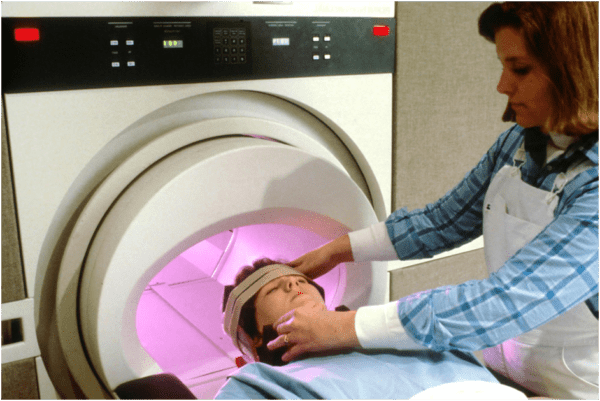
MRI (magnetic resonance imaging) is a non-invasive diagnostic imaging technology that uses a strong magnetic field, radio waves, and a computer to produce detailed images of the body’s internal structures. From full body MRI screening to functional MRI used to study brain function, there are numerous types and applications of this technology. This article will explore the importance of MRI technology and recent advancements that may influence your healthcare options in the future.
How Does MRI Technology Work?
During MRI screening, the patient lies down inside a large tube-shaped machine that contains a powerful magnet. This magnet generates a powerful and consistent magnetic field around the patient’s body.
Most protons in the body have a magnetic property referred to as a “spin” that causes them to align when the patient enters the magnetic field of the MRI machine. A radio frequency (RF) pulse is then applied, causing the aligned protons to absorb energy and alter their magnetic spin. When the RF pulse is switched off, the protons re-align with the magnetic field and release the absorbed energy.
As the protons release the absorbed energy, they emit signals that are detected and recorded by the MRI machine. These signals provide information about the location of the protons and their behavior in the patient’s tissues. These detected signals are then processed by a computer to generate highly detailed images of the body’s internal structures such as organs, bones, and blood vessels.
Why is MRI Technology Better Than X-rays?
While X-rays are well-suited for visualizing dense structures like bones, they are not as effective at visualizing soft tissues. On the other hand, MRI is very sensitive to changes in tissue composition and can detect subtle changes. This makes it a valuable tool for detecting early signs of disease such as tumors. MRI can also work with contrast agents to enhance the visibility of certain tissues and structures.
Unlike X-rays, MRI can produce images in multiple planes, allowing for a more comprehensive view of the body and better visualization of complex structures. Because it can detect multiple components within a patient’s tissue simultaneously, it also provides more accurate anatomical data than X-ray images do. MRI also provides high-resolution images that are more detailed than X-rays.
Finally, X-rays use ionizing radiation to produce images. This can be harmful to patients who are exposed to too much radiation over time. MRI technology, on the other hand, does not use ionizing radiation and is considered a safer option for imaging.
What are Recent Advancements in MRI Technology?
MRI technology has advanced significantly in recent years. One of the most notable advances is faster scanning. As MRI chambers can feel restrictive to some patients, new MRI technologies are being developed that can scan the body much faster, thus reducing patient discomfort and allowing for more MRIs to be performed each day. There are now even portable MRI systems that can be used in remote areas or during emergencies to quickly diagnose and treat injuries.
At the same time, there has been a major improvement in image resolution and contrast. High-field MRI systems use stronger magnetic fields to produce images that are of far superior quality. These systems can be used to diagnose a wider range of conditions. Some newer MRI systems also combine multiple types of scans to provide a more comprehensive view of the body. This can improve diagnostic accuracy and help identify conditions that may be missed by single-parameter MRI scans.
Artificial intelligence (AI) is being integrated into many types of technology and MRI is no exception. AI algorithms can be integrated into MRI systems to help automate the imaging process and allow doctors to spend less time administering tests. Real-time MRI imaging can also be used to facilitate MRI-guided interventions. During these procedures, doctors can perform minimally invasive procedures with the help of MRI images, thus improving the accuracy and effectiveness of the procedure.
What is the Future of MRI Technology?
As advancements in technology and research continue to improve the capabilities and accessibility of MRI imaging, the future of medical screening looks promising, Advances in imaging techniques are expected to improve the accuracy of diagnosing a variety of diseases such as cancer and heart disease. MRI may also be combined with other imaging technologies such as CT (Computed Tomography) scans to provide a much more comprehensive view of the internal body.
With the increasing availability of genomic and other biomarker data, MRI screening will become more personalized to an individual’s risk factors for certain diseases. When paired with full-body MRI screening, this could lead to earlier detection of tissue changes and more effective treatments for cancer. Advances in computer-aided and AI-based diagnosis could also enable more accurate predictions of outcomes, leading to better informed clinical decision-making processes.
In conclusion, MRI technology is a powerful tool that can help to diagnose and treat a variety of medical conditions including cancer. Advancements in MRI technology are already being used to improve patient care and outcomes, and new developments will likely continue to enhance MRI screening and provide numerous benefits to patients and clinicians alike. As MRI technology becomes more widely available, it is expected to play a vital role in the future of medicine.
 Gearfuse Technology, Science, Culture & More
Gearfuse Technology, Science, Culture & More


